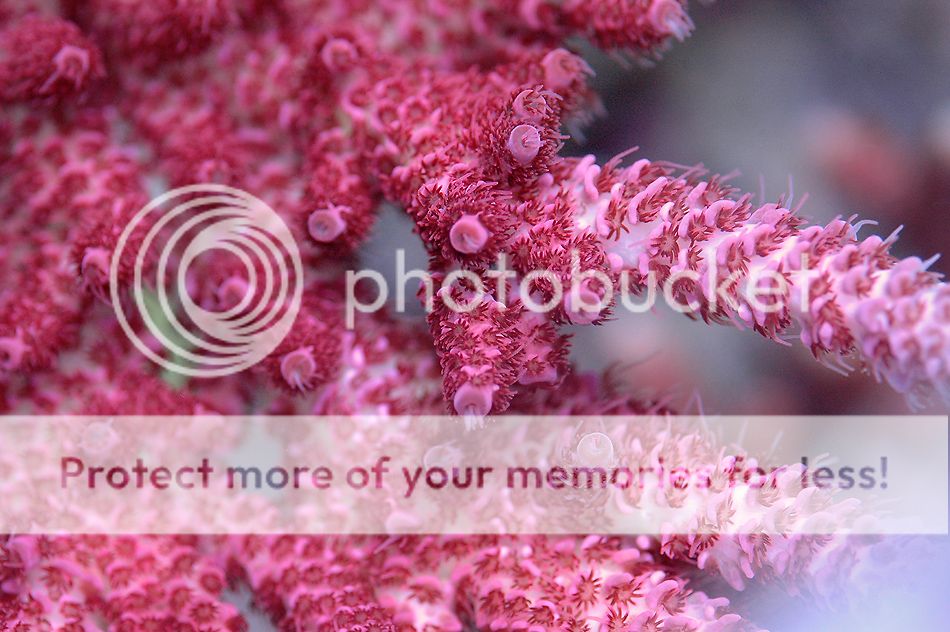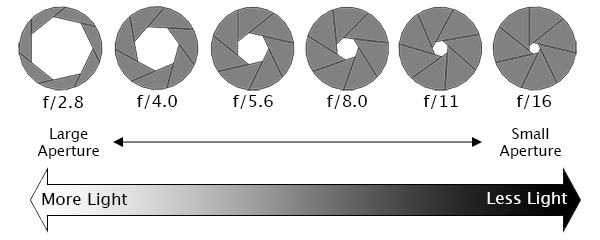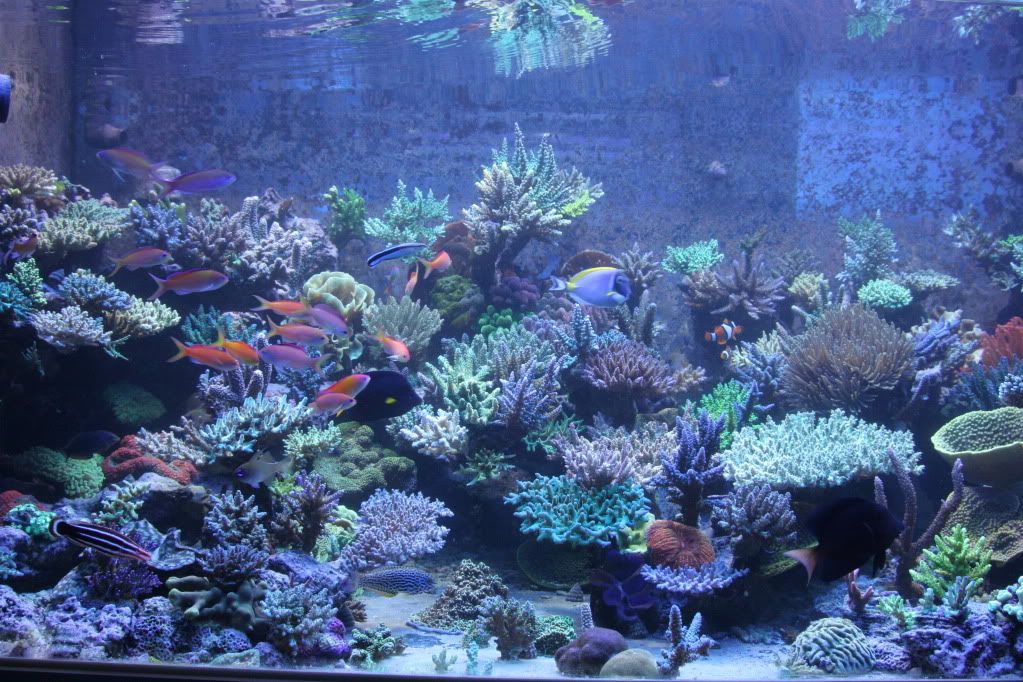You are using an out of date browser. It may not display this or other websites correctly.
You should upgrade or use an alternative browser.
You should upgrade or use an alternative browser.
47G SPS...Revamp
- Thread starter sahin
- Start date
SneekaPeek
New member
WOW!!!! that fts is looking quite delicious.
tmantaylor18
Active member
Loving the milli's Sahin, you're rainbow looks a lot like one of mine.
Where do you have your bubblegum, par wise?
Where do you have your bubblegum, par wise?
martinphillip03
New member
Very nice! Congrats on turning your tank around.
Marty
Marty
sahin
Ultimate Reefer
Thanks buddy, nice to get a compliment from one of the greats.Man those r freaking awesome pics. my friend.:beer:
Hey Bernie, thanks. As you know the tank was grown on the ATI, but I mentioned it a couple of pages back that the current shots were taken under the Pacific Sun unit.Wow all these from the ATI hybrid lights!!! I love the reddish and pink color sticks.
What is this full Fauna Marin Balling Lite System ?
The Fauna Marin system is a complete 3 Part System for dosing not only; Calcium, Alkalinity and Magnesium, but also Trace Elements.
Here is a link for further information-
Salts: http://www.faunamarin.de/en/balling/salts/ultra-balling-light-set/a-370/
Trace Elements:
http://www.faunamarin.de/en/balling/trace-b-balling-trace-elements/ultra-trace-b-health-elements-halogen-complex-500ml/a-177/
http://www.faunamarin.de/en/balling/trace-b-balling-trace-elements/ultra-trace-b-metabolic-elements-metal-trace-elements-complex-500ml/a-176/
http://www.faunamarin.de/en/balling/trace-b-balling-trace-elements/ultra-trace-b-color-and-grow-elements-strontium-barium-complex-500ml/a-77/
Since starting the Fauna Marin Complete Balling Lite System, I have noticed a definite increase in coral growth.
Beauty!!! Pure and simple.
Great pics and awesome health.
What software are using for post production?
The picture quality is top notch... Not to mention the corals..
Thanks buddy. The starting point for the nice sharp shots is my Tamron 90mm dedicated Macro lens: http://www.tamron.eu/uk/lenses/sp-af-90mm-f28-di-macro-11/
This lens is tack sharp. The software I use is Photoshop; crop, resize, levels adjustment (can correct some white balance errors) and finally some sharpening if required (No amount of sharpening is going to help if the original photo is out of focus/blurry).
Thank you. Appreciate the kind words. I couldnt image an SPS tank without the Red Planet Acro. Definitely pick one up.Sahin, I've been following the thread for a while and finally decided to chime in. Amazing colors and growth! That new frag similar to Pearlberry is going to be a stunning colony. Also that red planet is pretty awesome. I almost bought a frag of red planet at the LFS the other day but passed. Wish I wouldn't have. Inspiring tank for sure!
Thank you for looking into my thread. Your tank is a great inspiration. :beer:If you don't know, go with the flow and make your own....Sahin's Blue Passion.
Your colors are so vibrant! AWESOME job.
Thank you.That's fine. Such a beautiful and clean the tank. Corals are great.
Thanks for following the thread.WOW!!!! that fts is looking quite delicious.
Thanks man. I couldnt capture it but the blue tips on that Rainbow piece is the strongest blue colouration I've seen in a millepora. The Blue is more striking than the colouration on my Blue Tort.Loving the milli's Sahin, you're rainbow looks a lot like one of mine.
Where do you have your bubblegum, par wise?
The Bubblegum Millepora is being hit with VERY high flow and high light; minimum 450 PAR. I cant wait for this piece to colour up properly. It looks OK now, but I know what it can look like and cant wait to nurture this one into a stunning colony.
Very nice! Congrats on turning your tank around.
Marty
Thanks Marty.
Fantastic photos Sahin, the color in your acros is outstanding!
Thanks.
I'm on a lookout for a good deal on a used Nikon camera to replace my current one. Hopefully I will be able to provide some quality HD videos with good white balance.
sahin
Ultimate Reefer
Thanks. I'm glad to put the AEFW terror and the crash before that all behind. It's all a learning experience though.Going to echo what others said. It's really nice to see you posting success photos!
Sahin, are you shooting raw?
While I'm at it, where is your n and p atm?
So you are doing FM balling with their trace elements..
Are you using any Color Elements or any other additions?
I'm shooting JPEG. My camera does RAW, but I can never get the images to come out even remotely looking OK...have tried different RAW converters...images come out too blue; even if I selected very high K values in the raw converter. The camera is ancient by today's technology standards. I think it's around 12 years old the camera! :lol:
I take custom white balance readings within the camera by shooting at the tank and that gets it fairly close. But greens always come out dull and purples always look blue, so I adjust in Photoshop to get the images and coral colours to look same as what I see with my eyes.
PO4=0.03ppm
NO3=0.2ppm
I am only running the FM Balling Salts and TRACE parts. I'll add the Colour Elements in the next few months.
The best colours I obtained were a few years ago when I was running full Fauna Marin system. I've tried cheaper balling salts and just feel the results aren't as good as the Fauna Marin stuff.
biggles
Premium Member
Hot damn mate, beautiful colors on all your babies :thumbsup: Your photography puts mine to shame as usual 
I will never have enough of this one so keep taking pics of it......... :inlove:

I love that blue tort btw, that's really pretty in color and growth form. I like being jealous of your acros - it's about bloody time :beer:
I will never have enough of this one so keep taking pics of it......... :inlove:

I love that blue tort btw, that's really pretty in color and growth form. I like being jealous of your acros - it's about bloody time :beer:
jdraider75
Member
Sahin,
Where did you get GE 6500K? I looked for this tube in the past but could not locate it because GE did not supply it in 39W version in the UK. I bought Philips 6500 K instead.
When The Grim Reefer was the main contributor in the mother of all T5 threads, he always promoted this tube along with ATI blue + and ATI purple +. Once he left the thread people forgot about this tube.
http://www.aquariumspecialty.com/ge-starcoat-6500k-t5-ho-lamps
I recently added one to my combo. I run 5 blue plus 2 Fiji purple and a ge6500k.
Awesome pics Sahin! Tank looks great.
sahin
Ultimate Reefer
Hot damn mate, beautiful colors on all your babies :thumbsup: Your photography puts mine to shame as usual
I will never have enough of this one so keep taking pics of it......... :inlove:

I love that blue tort btw, that's really pretty in color and growth form. I like being jealous of your acros - it's about bloody time :beer:
Thanks mate. Hopefully in 6 months time I'll have a tank that I'm really proud of.
Thanks. Next time my friend. Frag for you if you want.The Acroporas looks amazing! That blue Tort is incredible. Well done! Too bad I didn't have time to visit when I was in London. Looking forward to more pictures:dance:
Thanks. How do you like the 6.5K GE? Does it help with colours?http://www.aquariumspecialty.com/ge-starcoat-6500k-t5-ho-lamps
I recently added one to my combo. I run 5 blue plus 2 Fiji purple and a ge6500k.
Awesome pics Sahin! Tank looks great.
The Oceanlife skims as well as my old Durso and box. It looks minimal and works fine. Its not any louder than the durso either. I dont really see it any different than bulkheads. Just looks nice and is plug and play.Sahin how are you liking the ocean life over flow? does it skim the water surface well? also do you think it is any different than just using regular bulk heads...?
jdraider75
Member
I think it helps with colors. I have only had it running for about a month but I like the look better than an aqua blue special. The growth has seemed to pick up a little also after adding the ge6500k but I added a blue reef Brite about the same time so it's really hard to say if it's the ge bulb or the reef Brite or both but so far I like the results.
reefmutt
Active member
Sahin, your shots are some of the most perfectly saturated and color balanced I have seen in the boards, not to mention the extreme clarity..
How do you set the color balance on your camera and what lights do you shoot the tank under?
Each time I visit your thread, I am re-dumbfounded by your latest shots..
How do you set the color balance on your camera and what lights do you shoot the tank under?
Each time I visit your thread, I am re-dumbfounded by your latest shots..
sahin
Ultimate Reefer
Thanks for looking into the thread. I'm so looking forward to seeing the tank in 6 months myself...the growth has taken off and colours are coming in.Acros are coming along nicely, looking really great. I can't wait to see this tank in 6 months or so.
I just need to STOP myself from buying any more Acros (I dread AEFW's despite QT etc) and keep things stable and going as they are. :fun5:
Thank you.great looking tank. And really nice Photography.
Thanks for the input. Once the colours of my corals have improved, I think I will be brave enough to put a 6.5K tube into the combo.I think it helps with colors. I have only had it running for about a month but I like the look better than an aqua blue special. The growth has seemed to pick up a little also after adding the ge6500k but I added a blue reef Brite about the same time so it's really hard to say if it's the ge bulb or the reef Brite or both but so far I like the results.
Matt, thanks for recognising my photography efforts. I always try and photograph with a White Balance as close to what I see.Sahin, your shots are some of the most perfectly saturated and color balanced I have seen in the boards, not to mention the extreme clarity..
How do you set the color balance on your camera and what lights do you shoot the tank under?
Each time I visit your thread, I am re-dumbfounded by your latest shots..
I shoot everything in MANUAL mode:
Apexture: I set it manually, and change for each shot. Bigger f number = greater Depth of Field, but images get darker as the aperture gets smaller.
I try and maintain an aperture of at least f11 to f16.
The bigger the f-number the more of your image is in focus (ie greater DOF).

Shutter Speed: I try and use at least 1/80 to 1/100. The bigger the number the faster image is captured and the less likely there will be blur and out of focus images.
ISO: is the sensitivity; I use typically ISO 600-800; modern DSLR's can go so much higher (like ISO 3200, before severe digital noise creeps in). The bigger the ISO, the faster the shutter speed and great the f-number you can use.
White Balance: Most of us reefkeepers have difficulty dealing with this aspect of photography. Older equipment and AUTO settings does NOT allow the camera to deal with the BLUE end of the light hitting the camera sensor. Once you figure out how to set the White Balance for your camera, the images become much better.
Setting your camera to a high K value allow most cameras to deal with our tank lighting:

Example of good and bad White Balance. The effect is very severe with tank photography.

I use a Nikon D70 camera which is around 12 years old, despite that I use the camera to the best of its ability to capture coral images with good colour representation. My camera has a CUSTOM White Balance Reading button. Basically you shoot at a section of your tank which best represent neutral gray. That means I take a custom shot of an area of the tank which has majority white eg sand works well. Or I might shoot half at my cabinet which is white and half of the frame if of the display.
I would highly recommend learning the individual settings for white balance for your camera.
Alternative to White Balance; use RAW: Most modern camera can take a photo in auto white balance, but retain all the colour info within the image. So within software you can choose the "K" setting. Ie setting to a 10K+ within the RAW converter software will reduce most of the blue.
Tank Lights:
I try and take all my photos during the PEAK period when the light is at its most white setting.
I have come to find the following the best for tank photography and coral colours:
T5: a mix of 2/4 White tubes, 1/4 Actinic and 1/4 Blue
LED: Blue channels at 100% and white channel at 50%
With my Pacific Sun light unit, there are no White LED's, but it has Blue, Cyan, Green, Red etc etc hence gives the appearance of white light. With my ATI unit I find setting as described above gives a 14-20K look and the camera deals with the overall BLUE look quite fine.
Quality of images:
My camera is old and only 6MP. But it is the lens which provides the nice, clear and sharp images.
To a certain point, a high quality lens on a standard DSLR will produce better images than a crappy lens on an expensive camera.
I use the Tamron 90mm Macro lens which is excellent quality in terms of images it produces:
Examples from mnaufacturer website: http://www.tamron.eu/uk/lenses/sp-af-90mm-f28-di-macro-11/



Also, your tank is making me question wether to abandon my ca reactor (which I have used for 15 years..) and go fauna Marin balling...
Dont. If it weren't for the upfront cost of setting one up, I'd have switched a long time ago. I am a member on at least 15 different USA/Canadian/Aussie/Brit reef forums; I've read 100's of build threads. IMO Ca reactors are better. My buddy Ahmed runs an ATI LED Powermodule with a DaStaco Ca reactor; the SPS colours are as good as any Radium light system.
GFO + excessive GAC use is VERY counter productive to SPS colours. Limit their use as much as possible.
I dose using the FM Balling system, but use the trace elements because I feel they help. A Ca reactor provides all of this. FM Balling system can get very costly for large size tanks as well.
My feeling is: Ca reactor or 2/3 part with trace + lots of fish + lots of food + stable parameters + decent light = colouful SPS.
This is what you achieved before.

Run your current system the same way. I see an AMAZING system. Lots of colourful corals. Lots of fish. I bet you didnt strip the nutrients. Or run excessive amounts of GFO and GAC. Your old system either matches of betters many TOTM's. I seriously mean that. Just stick with basics and do what you are already good at.
